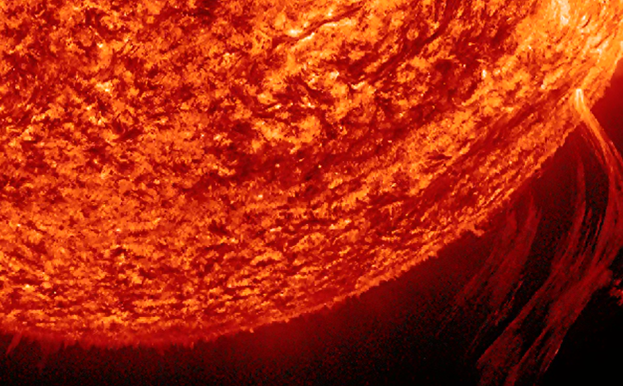Filaments are clouds of cooler gas trapped between magnetic fields of opposite polarity. Seen in suitable filters, they look like dark lines and strands against the hotter solar disk. Near the limb, when their silhouette is observed, they glow as towering, torches, hedges and arches. They are then called prominences.
During the evening hours of September 9th, a small but dynamic filament turned around the southwestern solar limb, very near the southern solar pole. Only a few hours later (morning of September 10th), the magnetic regions surrounding the prominence became unstable, and an ejection of the material took place. This can be seen in images from the Sun's chromosphere made by the GONG-observatories.
A few hours later, the coronal mass ejection (CME) was also observed with the coronagraphs onboard STEREO-A, showing a pear-shaped cloud of ionized gas (plasma) moving away from the Sun. Such CME's have a mass comparable to that of a well-sized Alp mountain, and a speed in excess of 1.5 million kilometers per hour. A good thing this CME was not directed towards Earth!

Interestingly, some of the erupting material was captured by the Sun's magnetic field and graciously guided back into the lower solar atmosphere. This can be seen as a brightening south of an active (bright) region near the southwestern limb. The brightening is only seen in the EUV-clips, not in H-alpha, meaning that the crashing of the ejected material into the denser lower atmosphere of the Sun took place in the lower corona (above the chromosphere). The speed of the plasma at the end of the 750.000 km long loop is on the average half a million kilometers per hour!

A clip of the event can be seen here. It shows:
- the filament and subsequent prominence eruption in H-alpha (GONG);
- the CME as seen by STEREO-A's coronagraph. Note the CME is on the southeast part of the Sun (lower left), because of the satellite’s position relative to the Sun and Earth;
- the part of the material that is flowing back to the Sun. It consists of a combination of EUV-images by SDO and by the wider field PROBA2/SWAP instrument;
- zoom-in on the area with SDO-images (first AIA 171, then AIA 304). The beginning of both clips still show some part of the filament (dark, swinging strands) very well before the final eruption.
- the EUV-view by STEREO-A where the ejected material can be seen returning to the Sun, albeit weakly (lower left, "east").
 |
 |





